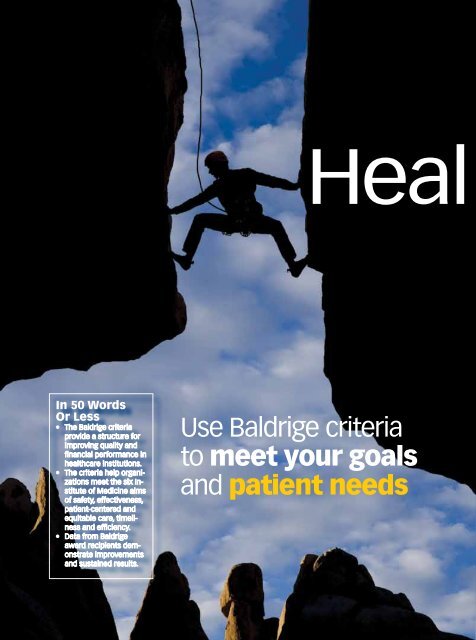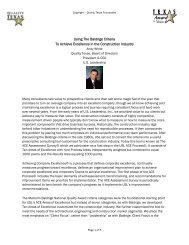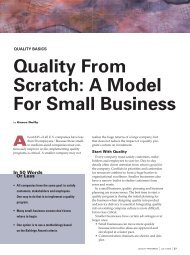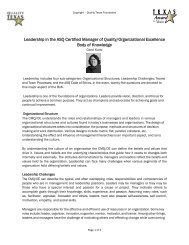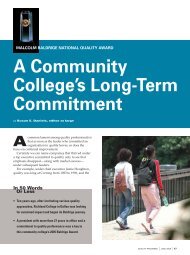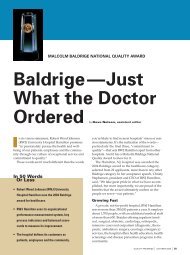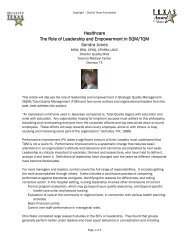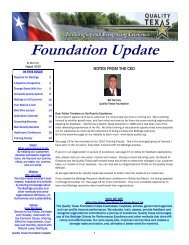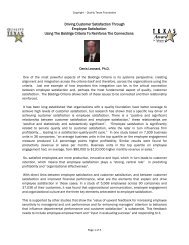Use Baldrige criteria to meet your goals and patient ... - Quality Texas
Use Baldrige criteria to meet your goals and patient ... - Quality Texas
Use Baldrige criteria to meet your goals and patient ... - Quality Texas
- No tags were found...
You also want an ePaper? Increase the reach of your titles
YUMPU automatically turns print PDFs into web optimized ePapers that Google loves.
healthcareNarrowthcare’s<strong>Quality</strong>Chasmby William Denney,Cynthia St. John <strong>and</strong>Liz Youngblood<strong>to</strong>day’s healthcare leadersface the need <strong>to</strong> effectively manage both the clinical<strong>and</strong> business sides of their operations. This includesdemonstrating cost reductions, overall organizationalimprovement <strong>and</strong> long-term sustainability.Added <strong>to</strong> these responsibilities are the societal expectationsthat these leaders make radical changes <strong>to</strong>the healthcare infrastructure while it still consistently<strong>meet</strong> the needs of <strong>patient</strong>s <strong>and</strong> that these leaders doso in a field that is quite complex. The bot<strong>to</strong>m line isthat hospitals have no choice but <strong>to</strong> move from basiccompliance <strong>to</strong> organizational excellence.May 2009 • QP 39
Implementing the <strong>Baldrige</strong> Healthcare Criteria forPerformance Excellence 1 within a healthcare organizationcan drive high-quality outcomes <strong>and</strong> improvefinancial performance. The <strong>Baldrige</strong> <strong>criteria</strong> provide astructure <strong>to</strong> help align <strong>and</strong> focus all areas of an organizationwith key stakeholder needs <strong>and</strong> expectations. Inshort, the <strong>criteria</strong> can transform healthcare.In the midst of striving for organizational excellence,healthcare institutions are faced with a variety of challenges.For example, no one can deny that healthcareis a highly regulated industry. Staying up <strong>to</strong> date withchanging requirements is costly in time <strong>and</strong> resourcesthat don’t generate additional revenue.An organization that does not maintain compliance,however, will lose money in the form of penalties, decreasesin payments, required reimbursement of fundsreceived <strong>and</strong> even failure <strong>to</strong> qualify <strong>to</strong> serve certainpayer categories.Another challenge faced by full-service, acute carehospitals is providing healthcare <strong>to</strong> all, regardless ofability <strong>to</strong> pay. Emergency <strong>and</strong> subsequent healthcareservices are provided regardless of whether a <strong>patient</strong>can pay for the services.Many healthcare consumers cannot afford insurance.Others have insurance but cannot pay the increasingco-pay amounts <strong>and</strong> other consumer-fundedportions of healthcare plans. This added financial burdenon hospitals, along with the increasing regula<strong>to</strong>rycompliance requirements, is cause for concern. Hospitalsthat are unable <strong>to</strong> <strong>meet</strong> these challenges end upclosing their doors because they can’t financially sustaintheir operations.Additionally, consumers (<strong>patient</strong>s) are much moreinvolved in making healthcare decisions, <strong>and</strong> expectationsfor transparency have become the norm. Patientconsumers decide what healthcare services they want<strong>to</strong> receive <strong>and</strong> where they want <strong>to</strong> receive them. Thesedecisions are based on accessible information related<strong>to</strong> services, quality <strong>and</strong> other outcomes.Furthermore, high-quality, cost-effective care withpositive outcomes is expected. For consumers, this is agiven; therefore, <strong>patient</strong> satisfaction has become a keydriver in determining where <strong>patient</strong>s will go <strong>to</strong> receiveservices.All these fac<strong>to</strong>rs create a challenging environmentfor healthcare institutions. Addressing these challenges<strong>and</strong> moving beyond them <strong>to</strong> create organizationalexcellence are critical <strong>to</strong> success <strong>and</strong> sustainability.<strong>Quality</strong> <strong>and</strong> the IOM aimsInitial efforts <strong>to</strong> achieve improvement have frequentlybeen associated with the Institute of Medicine (IOM)aims. In its l<strong>and</strong>mark report Crossing the <strong>Quality</strong>Chasm, IOM acknowledged the existence of a pervasivequality gap <strong>and</strong> called for the urgent redesign ofthe U.S. healthcare system. 2The report set forth the following six aims for focusedimprovement:• Safety—avoiding injuries <strong>to</strong> <strong>patient</strong>s from the careintended <strong>to</strong> help them.• Effectiveness—providing services based on scientificknowledge <strong>to</strong> all who could benefit while refrainingfrom providing services <strong>to</strong> those unlikely <strong>to</strong>benefit.• Patient-centered care—providing care that is respectfulof <strong>and</strong> responsive <strong>to</strong> individual <strong>patient</strong> preferences,needs <strong>and</strong> values, <strong>and</strong> ensuring that <strong>patient</strong>values guide all clinical decisions.• Timeliness—reducing wait times <strong>and</strong> sometimesharmful delays for those who receive <strong>and</strong> those whogive care.• Efficiency—avoiding waste, including unusedequipment <strong>and</strong> supplies, ignored ideas <strong>and</strong> unnecessaryexpenditures of energy.• Equitable care—providing care that does not varyin quality because of personal characteristics suchas gender, ethnicity, geographic location <strong>and</strong> socioeconomicstatus.Intended <strong>to</strong> result in care that is safer, more reliable,more responsive, more integrated <strong>and</strong> more available,these aims became the focus of many healthcare institutions’quality efforts.Since the report’s release, some gains have beenachieved. These <strong>to</strong>pics continue <strong>to</strong> cause unrest withinthe healthcare industry, however—opportunities forimprovement persist. In a time when great leaps forwardare needed, progress is <strong>to</strong>o often measured insmall, incremental improvements. Leaders find themselvessupporting <strong>and</strong> financing many seemingly good,but r<strong>and</strong>om, acts of improvement. Despite best intentions,costs continue <strong>to</strong> rise, <strong>patient</strong>s remain dissatisfied,<strong>and</strong> process failures are widespread.What is needed is a systematic way <strong>to</strong> align hospitalimprovement activities with strategic <strong>goals</strong> <strong>and</strong><strong>to</strong> track focused measures that result in real change.Since its availability in 1999, the <strong>Baldrige</strong> healthcare<strong>criteria</strong> have been used by many hospitals <strong>to</strong> accom-40QP • www.qualityprogress.com
healthcareplish this alignment <strong>and</strong> tracking. The <strong>criteria</strong> representa systems approach <strong>to</strong> improvement that is composedof six process categories <strong>and</strong> a seventh categoryfor associated results:1. Leadership.2. Strategic planning.3. Focus on <strong>patient</strong>s, other cus<strong>to</strong>mers <strong>and</strong> markets.4. Measurement, analysis <strong>and</strong> knowledge management.5. Workforce focus.6. Process management.7. Results.The <strong>criteria</strong> have also been referred <strong>to</strong> as a leadershipsystem <strong>and</strong> a sustainability model. But what theyreally represent is an integrated approach <strong>to</strong> improvinga diverse <strong>and</strong> complicated organization <strong>and</strong> achievingsustainable results.<strong>Baldrige</strong> <strong>and</strong> the IOM aimsWhile the <strong>criteria</strong> address key processes in an effectivemanagement system <strong>and</strong> are increasingly recognizedas a framework <strong>to</strong> create <strong>and</strong> sustain quality outcomes,the greatest emphasis is placed on the outcomesachieved by these processes. Table 1 (p. 42) summarizesthe <strong>Baldrige</strong> results <strong>criteria</strong> relative <strong>to</strong> the IOM aims.Systematic application of the <strong>criteria</strong> often correspondswith significant gains in IOM aim achievement.Following are examples of results from <strong>Baldrige</strong> recipientsthat impact IOM aims:Safety: The provision of safe care is dependent ona variety of fac<strong>to</strong>rs. It therefore follows that safety also<strong>to</strong>uches many of the <strong>Baldrige</strong> results items. Most directly,the healthcare outcomes <strong>criteria</strong> (7.1) ask forlevels, trends <strong>and</strong> comparative results relative <strong>to</strong> <strong>patient</strong>safety.Also relevant, however, are workforce-focusedoutcomes due <strong>to</strong> the human fac<strong>to</strong>rs often associatedwith medical errors. Workforce capability <strong>and</strong> capacity,including staffing levels <strong>and</strong> appropriate skills, areaddressed by the workforce-focused outcomes <strong>criteria</strong>(7.4).In addition, safe care is aligned with the <strong>Baldrige</strong>process effectiveness outcomes (7.5) <strong>and</strong> leadershipoutcomes (7.6). Key work-process measures, includingthose directly <strong>and</strong> indirectly related <strong>to</strong> the provisionof safe care, are addressed in 7.5. Leadership sets theinstitution’s strategic objectives <strong>and</strong> priorities <strong>and</strong> isresponsible for moni<strong>to</strong>ring progress <strong>to</strong>ward these priorities(7.6), of which safe care should be paramount.Patient safety cultureexample / figure 1Percentage of staff thatview issue as a problem302520151050Specificprocess <strong>to</strong>reviewperformanceagainstdefinedtraining <strong>goals</strong>Accreditation results (such as Joint Commission requirements)are also addressed in the leadership outcomes<strong>criteria</strong>.Given the relation between the <strong>Baldrige</strong> results <strong>criteria</strong><strong>and</strong> the IOM safety aim, it is not surprising that<strong>Baldrige</strong> award recipients often demonstrate stronger<strong>patient</strong> safety outcomes compared with their peers.In Figure 1 from <strong>Baldrige</strong> award recipient NorthMississippi Medical Center, as <strong>patient</strong> safety improvementbecomes part of an organization’s processes <strong>and</strong>culture, staff recognizes that actions <strong>to</strong> improve safetyare visible <strong>and</strong> well implemented.Figure 2 from St. Luke’s Hospital of Kansas Cityshows that mortality rates were lower, which impactsother important measurements compared with nationalaverages.SLHRewardedfor takingquick action<strong>to</strong> identifya seriousmistakeNorth Mississippi Medical CenterSelect group <strong>to</strong>p 10%Lower mortalityrates / figure 2National averageMedical mortality 13.1% 15.3%Surgical mortality 1.8% 15.3%Physician rating 86% 33%Accreditation score 92 91Overall score 7669 5418St. Luke’s Hospital (SLH) Rank = 35 of 4,500hospitals in United StatesGoodProvidesteamworktraining <strong>to</strong>improve<strong>patient</strong> careperformance<strong>and</strong> safetyMay 2009 • QP 41
<strong>Baldrige</strong>results ⇒7.1HealthcareoutcomesEffectiveness: Evidence-based medicine has experiencedcontinued refinement, with specific treatmentstrategies demonstrating consistently better results for<strong>patient</strong>s with specific presenting conditions.The delivery of effective care, as defined by the IOM,relates <strong>to</strong> providing services <strong>to</strong> all who could benefit,while refraining from providing services <strong>to</strong> those notlikely <strong>to</strong> benefit—in other words, the effective use ofevidence-based medicine as available <strong>and</strong> appropriate.These practices <strong>and</strong> their corresponding results are addressedin the healthcare outcomes <strong>criteria</strong> (7.1).In addition <strong>to</strong> <strong>patient</strong> safety outcomes identifiedearlier, the healthcare outcomes <strong>criteria</strong> ask for levels,trends <strong>and</strong> comparative results relative <strong>to</strong> healthcareoutcomes <strong>and</strong> <strong>patient</strong>s’ functional status.An additional means by which overall effectivenessis achieved is through the effective design, implementation<strong>and</strong> improvement of healthcare delivery processes.These processes are measured by item 7.5,process effectiveness outcomes. In particular, 7.5 asksfor current levels <strong>and</strong> trends for the operational performanceof key work processes, including productivity,cycle time <strong>and</strong> other appropriate measures of processeffectiveness.Table 1 also identifies the workforce-focused item(7.4) as relevant <strong>to</strong> the IOM effectiveness aim. Thisconnection is based on the importance of workplaceclimate <strong>and</strong> engagement, particularly related <strong>to</strong> openness<strong>to</strong> new ideas, approaches <strong>and</strong> improvement opportunities<strong>to</strong> ensure ongoing gains in effectiveness.<strong>Baldrige</strong> award recipients generally demonstrate<strong>Baldrige</strong> results <strong>and</strong> IOM aims / Table 17.2Patient7.3Financial7.4<strong>and</strong> other <strong>and</strong> marketcus<strong>to</strong>merfocusedoutcomesoutcomesWorkforcefocusedoutcomes7.5 7.6Process LeadershipeffectivenessoutcomesoutcomesIOM aims⇓Care is:1. Safe • • • •2. Effective • • • •3. Patientcentered•4. Timely •5. Efficient • • •6. Equitable • •IOM = Institute of Medicinestronger effectiveness-related outcomes comparedwith their peers. Looking <strong>to</strong> clinical measures of effectiveness(see Online Figure 1 at www.qualityprogress.com), one <strong>Baldrige</strong> award recipient shows results thatare better than measurements from the Centers forMedicare <strong>and</strong> Medicaid Services (CMS). As shown inOnline Figure 2, the recipient performed better than localcompeti<strong>to</strong>rs <strong>and</strong> as good as the best in the country,as measured by the Agency for Healthcare Research<strong>and</strong> <strong>Quality</strong> (AHRQ).Patient-centered care: The IOM aim of <strong>patient</strong>centeredcare emphasizes responsiveness <strong>to</strong> <strong>patient</strong>preferences, needs <strong>and</strong> values. Similarly, category 3of the <strong>Baldrige</strong> <strong>criteria</strong> <strong>and</strong> corresponding item 7.2 inthe results section address <strong>patient</strong> <strong>and</strong> other cus<strong>to</strong>merfocusedprocesses <strong>and</strong> outcomes.In particular, the results <strong>criteria</strong> ask for levels,trends <strong>and</strong> comparative data relative <strong>to</strong> <strong>patient</strong>/cus<strong>to</strong>mersatisfaction <strong>and</strong> dissatisfaction, perceived value,retention <strong>and</strong> positive referral. These measuresprovide an indication of how a healthcare institution isperforming relative <strong>to</strong> <strong>patient</strong>-centered care.Similar <strong>to</strong> the aims already discussed, <strong>Baldrige</strong>award recipients tend <strong>to</strong> demonstrate stronger <strong>patient</strong>centeredoutcomes compared with their peers. Figure3 shows high scores for <strong>patient</strong> loyalty at BronsonMethodist Hospital, a <strong>Baldrige</strong> recipient. Table 2 showsa comparison of cus<strong>to</strong>mer value at award recipientBaptist Hospital Inc. in Pensacola, FL, <strong>and</strong> comparableinstitutions.Timeliness: In <strong>Baldrige</strong> terminology, timeliness isone aspect of the process effectiveness outcomes <strong>criteria</strong>(7.5).In addition <strong>to</strong> the general operational performanceof work systems <strong>and</strong> key work processes, time-basedmeasures play a large role in the <strong>criteria</strong>, given thesignificance of time performance <strong>to</strong> improving overallperformance. Appropriate measures <strong>and</strong> indica<strong>to</strong>rsof work system performance may include just-in-timedelivery of healthcare <strong>and</strong> related services, plus otherindica<strong>to</strong>rs that demonstrate responsiveness, such ascycle times, turnaround times, time <strong>to</strong> new healthcareservice introduction <strong>and</strong> order fulfillment time.Given the inherent emphasis on time-based measuresof performance, <strong>Baldrige</strong> award recipients regularlydemonstrate reduced times on key measuresas compared with their peers. For example, OnlineFigure 3 shows process speed improvement at Rob-42QP • www.qualityprogress.com
healthcareert Wood Johnson University Hospital Hamil<strong>to</strong>n, NJ,a <strong>Baldrige</strong> winner, compared with Joint Commissionresults. Online Figure 4 shows a comparison betweenthe timeliness of antibiotics given <strong>and</strong> length of stay atBronson Methodist Hospital.Efficiency: Also closely related <strong>to</strong> the timely deliveryof care <strong>and</strong> services is the efficiency with whichhealthcare processes are delivered. Efficiency encompassesall forms of waste avoidance, including equipment,supplies, human resources <strong>and</strong> even ignoredideas.The aim of providing efficient care is related <strong>to</strong> multiple<strong>Baldrige</strong> results items:• Financial <strong>and</strong> market outcomes (item 7.3) addressesfinancial performance measures, including levels<strong>and</strong> trends for budget performance—a measure offinancial efficiency.• Workforce-focused outcomes (7.4) take in<strong>to</strong> considerationthe concept of avoiding waste in the formof ignored ideas. As noted earlier in reference <strong>to</strong>the IOM effectiveness aim, the importance of workplaceclimate <strong>and</strong> workforce engagement—particularlyrelated <strong>to</strong> openness <strong>to</strong> new ideas, approaches<strong>and</strong> improvement opportunities—can also significantlyimpact efficiency.• Process effectiveness outcomes (7.5) address theoperational performance of work systems <strong>and</strong> keywork processes, including productivity <strong>and</strong> efficiencymeasures. Indica<strong>to</strong>rs of process efficiency mightinclude work system performance that demonstratesincreased cost savings, higher productivityor waste reduction, such as the reduction of repeatdiagnostic tests <strong>and</strong> cost reduction.<strong>Baldrige</strong> award recipients tend <strong>to</strong> demonstratestronger efficiency-related outcomes compared withtheir peers. Figure 4 (p. 44) shows how St. Luke’s Hospitalof Kansas City increased its profit margins byeliminating internal inefficiencies. In Online Figure 5,despite increases in volume, Baptist Hospital Inc. tended<strong>to</strong> create the capacity for fast response times <strong>and</strong>best-in-class performance.Equitable care: Healthcare results (7.1) addresskey measures of healthcare outcomes, including functionalstatus.Although many <strong>Baldrige</strong> recipients serve lower income<strong>and</strong> rural <strong>patient</strong>s, their healthcare outcomes aregenerally equal <strong>to</strong> or better than facilities serving moreaffluent communities. Results such as these supportLoyalty <strong>and</strong> likeliness<strong>to</strong> return / figure 3Mean score54321In<strong>patient</strong> ER OPsurgeryBronson MethodistHospital (BMH) baselineGallupER = emergency room; OP = out<strong>patient</strong>the aim of equitable care.In addition, leadership results (7.6) measure a varietyof fac<strong>to</strong>rs, including support of key communities<strong>and</strong> contribution <strong>to</strong> the health of the community theinstitution serves, regardless of its characteristics.Cus<strong>to</strong>mer survey scores / Table 2Baptist Hospital Inc. (BHI)Issue BHI A BCare/servicesPatients are kept sufficiently informed about theircondition/treatment.Pain is well controlled.Personnel show concern for <strong>patient</strong>s’ well-being.Overall quality of health care provided is excellent.Phone representatives at hospital are helpful.Sufficient personal attention is given <strong>to</strong> <strong>patient</strong>s.Patient needs are met promptly.Waiting time for tests <strong>and</strong> treatment is reasonable.+8484+88+83+84+83+79+7779807878777773717677737473707068EmotionalPatient needs are unders<strong>to</strong>od. +78 71 62Location/environmentParking is convenient. +76 62 49NursesNurses show good attitide <strong>to</strong>ward <strong>patient</strong> requests. +89 79 78PhysiciansOverall quality of care provided by physician is excellent. 83 80 80+ = Significantly above competition (A <strong>and</strong> B)OPtestingGood100806040200Percentile rankingBMH 1Q ‘05 projectedBMH baseline percentileMay 2009 • QP 43
Margin comparison / figure 41816Better141210864201999 2000 2001 2002 2003St. Luke’s Hospital (SLH)Top quartileCouncil of Teaching Hospitals <strong>and</strong> Health Systems*SLH data represent best 5% of comparative groupPercentageUncompensated costcomparison / figure 512%10%8%6%4%2%0%Percentage of <strong>to</strong>tal expenses2002 2003 2004 2005 2006 year<strong>to</strong> dateNorth Mississippi Medical Center actualNational, per American Hospital Association<strong>Baldrige</strong> recipients tend <strong>to</strong> be able <strong>to</strong> spend moreon uncompensated <strong>and</strong> charity care than comparableinstitutions. Figure 5 shows how <strong>Baldrige</strong> recipientNorth Mississippi Medical Center posted uncompensatedexpenses above a national average. Online Figure6 shows how setting a percentage of operating marginin an environment of increased efficiency <strong>and</strong> financialimprovement resulted in increased charity care at <strong>Baldrige</strong>award recipient SSM Healthcare.Getting startedAn organization can start using the <strong>Baldrige</strong> <strong>criteria</strong> <strong>to</strong>create a change in culture leading <strong>to</strong> an improvementin quality by completing two steps: the organizationalprofile <strong>and</strong> the self-assessment.Step one—organizational profile: The profileserves as the DNA for an organization. It provides clarityabout who you are, what you do, for whom you do it,what they expect, with whom you are competing <strong>and</strong> collaborating,<strong>your</strong> key strategic challenges <strong>and</strong> advantages,<strong>and</strong> the approach you use <strong>to</strong> improve performance.Although the questions that must be answered areseemingly straightforward, within many organizationsthe responses have traditionally been treated asimplicit assumptions rather than explicit assertions.Arriving at a collective <strong>and</strong> uniform response <strong>to</strong> eachquestion provides focus <strong>to</strong> the leadership team <strong>and</strong> organization.This collective consciousness becomes thecontext within which the organization operates <strong>and</strong>against which it manages its performance.Step two—self-assessment: The profile describeswho you are <strong>and</strong> the environment in which you operate.The self-assessment describes how you currentlyperform relative <strong>to</strong> the <strong>Baldrige</strong> <strong>criteria</strong>.Current practices are reviewed <strong>and</strong> summarized inthe areas of leadership, strategic planning, cus<strong>to</strong>merfocus, measurement/analysis, knowledge management,workforce focus, process management <strong>and</strong> results.Although often an impressive document in its ownright, the true value of this process comes from usingthe information <strong>to</strong> identify the organization’s strengths<strong>and</strong> opportunities for improvement, which are basedon its responses <strong>to</strong> the <strong>criteria</strong> <strong>and</strong> placed in the contex<strong>to</strong>f what it stated was important in its profile. Theopportunities for improvement represent gaps that canbe prioritized, translated in<strong>to</strong> <strong>goals</strong> <strong>and</strong> integrated in<strong>to</strong>the organization’s strategic planning <strong>and</strong> performancemanagement processes.Completing the profile <strong>and</strong> self-assessment help anorganization readily see its gaps <strong>and</strong> current barriers <strong>to</strong>success. Systematically using this information in the strategicplanning process will enable the development <strong>and</strong>achievement of meaningful <strong>goals</strong> <strong>and</strong> improvements.<strong>Baldrige</strong> resultsAre you interested in learning more about the exceptional businessresults achieved by <strong>Baldrige</strong> recipients? Go <strong>to</strong> www.quality.nist.gov/Contacts_Profiles.htm (case sensitive).Not just an awardThe <strong>Baldrige</strong> <strong>criteria</strong> are not about receiving anaward. In healthcare <strong>and</strong> hospitals, there are manyquality awards <strong>and</strong> recognitions, but few nationally44QP • www.qualityprogress.com
healthcarerecognized systematic <strong>and</strong> integrated approaches forsustainable improvement.There is a misconception that the <strong>criteria</strong> are difficult<strong>to</strong> use <strong>and</strong> underst<strong>and</strong>, are costly or that it takesa long time <strong>to</strong> see benefit. In fact, the <strong>criteria</strong> are easy<strong>to</strong> underst<strong>and</strong>. But changing an organization’s culture <strong>to</strong>use the <strong>criteria</strong> can be a challenge. It requires leadershipcommitment <strong>to</strong> drive excellence. A committed leadershipteam can effectively create the culturechange required <strong>to</strong> begin using the <strong>criteria</strong>within the organization. If this is done, thepayoff can be almost immediate.There is a growing recognition withinhealthcare of the value of the <strong>Baldrige</strong> <strong>criteria</strong>.In 2008, 50% of the applicants thatapplied for feedback from the <strong>Baldrige</strong> programwere from the healthcare sec<strong>to</strong>r. Thesame is true for many state programs. Most<strong>Baldrige</strong> award recipients prepared themselves<strong>to</strong> succeed at the national level byparticipating in their state program.Whatever the route taken, the resultsshow that the <strong>Baldrige</strong> <strong>criteria</strong> can providea structured way for healthcare institutions<strong>to</strong> <strong>meet</strong> many of the seemingly overwhelmingchallenges they face <strong>to</strong>day. QPCYNTHIA ST. JOHN is direc<strong>to</strong>r ofjourney <strong>to</strong> excellence for <strong>Texas</strong> HealthResources in Hous<strong>to</strong>n. She earneda doc<strong>to</strong>rate in psychology, with aresearch emphasis on organizationallearning <strong>and</strong> improvement, from theUniversity of Hous<strong>to</strong>n. She receivedthe 2008 Carroll Morrison ExaminerAward for outst<strong>and</strong>ing leadership <strong>and</strong> service <strong>to</strong> <strong>Quality</strong><strong>Texas</strong>.References1. <strong>Baldrige</strong> Healthcare Criteria for Performance Excellence,National Institute of St<strong>and</strong>ards <strong>and</strong> Technology, 2008.2. Crossing the <strong>Quality</strong> Chasm, Institute of Medicine, 2001.ResourcesTo learn more about the <strong>Baldrige</strong> <strong>criteria</strong>, go <strong>to</strong> www.quality.nist.gov.For more information about state <strong>Baldrige</strong>-based programs,go <strong>to</strong> www.baldrigepe.org/alliance.<strong>Baldrige</strong> recipient information is available at www.quality.nist.gov/Contacts_Profiles.htm (case sensitive).WILLIAM DENNEY is CEO of the <strong>Quality</strong><strong>Texas</strong> Foundation. He earned a doc<strong>to</strong>ratein his<strong>to</strong>ry from Miami University inOxford, OH. Denney is a senior memberof ASQ <strong>and</strong> is a certified qualitymanager <strong>and</strong> audi<strong>to</strong>r. He has been a<strong>Baldrige</strong> examiner for 10 years <strong>and</strong> ischair of the ASQ <strong>Quality</strong> ManagementDivision’s <strong>Baldrige</strong> technical committee.LIZ YOUNGBLOOD, a registered nurse,is vice president of <strong>patient</strong> caresupport services for the Baylor HealthCare System in Dallas. She earnedan MBA from Southern MethodistUniversity in Dallas.May 2009 • QP 45


